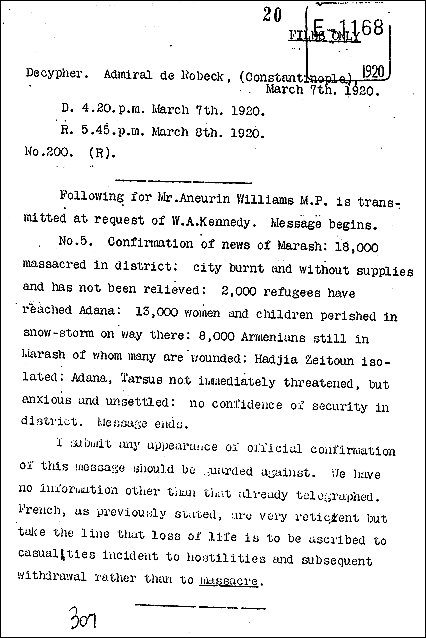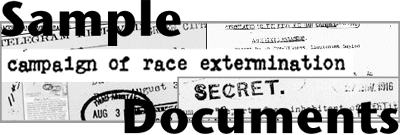Report on the massacre of Armenians in Cilicia under French administration. March 7, 1920.
_____________________________________________
Decypher, Admiral de Robeck, (Constantinople),
March 7th, 1920.
D. 4.20. p.m. March 7th. 1920.
R. 5.45. p.m. March 8th. 1920.
No.200. (R).
_________________
Following for Mr. Aneurin Williams M.P. is transmitted at request of W.A. Kennedy. Message begins.
No. 5. Confirmation of news of Marash: 18,000 massacred in district: city burnt and without supplies and has not been relieved: 2,000 refugees have reached Adana: 13,000 women and children perished in snow-storm on way there: 8,000 Armenians still in Marash of whom many are wounded: Hadjia Zeitoun isolated: Adana, Tarsus not immediately threatened, but anxious and unsettled: no confidence of security in district. Message ends.
I submit any appearance of official confirmation of this message should be guarded against. We have no information other than that already telegraphed. French, as previously stated, are very reticent but take the line that loss of life is to be ascribed to casualties incident to hostilities and subsequent withdrawal rather than to massacre.
_____________________________________________
Decypher, Admiral de Robeck, (Constantinople),
March 7th, 1920.
D. 4.20. p.m. March 7th. 1920.
R. 5.45. p.m. March 8th. 1920.
No.200. (R).
_________________
Following for Mr. Aneurin Williams M.P. is transmitted at request of W.A. Kennedy. Message begins.
No. 5. Confirmation of news of Marash: 18,000 massacred in district: city burnt and without supplies and has not been relieved: 2,000 refugees have reached Adana: 13,000 women and children perished in snow-storm on way there: 8,000 Armenians still in Marash of whom many are wounded: Hadjia Zeitoun isolated: Adana, Tarsus not immediately threatened, but anxious and unsettled: no confidence of security in district. Message ends.
I submit any appearance of official confirmation of this message should be guarded against. We have no information other than that already telegraphed. French, as previously stated, are very reticent but take the line that loss of life is to be ascribed to casualties incident to hostilities and subsequent withdrawal rather than to massacre.












Comment